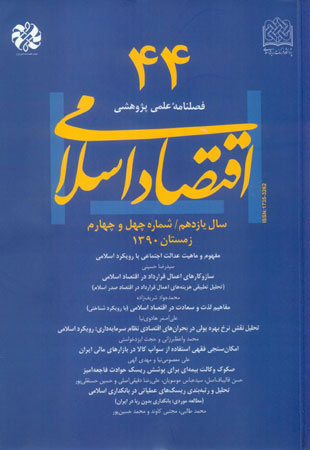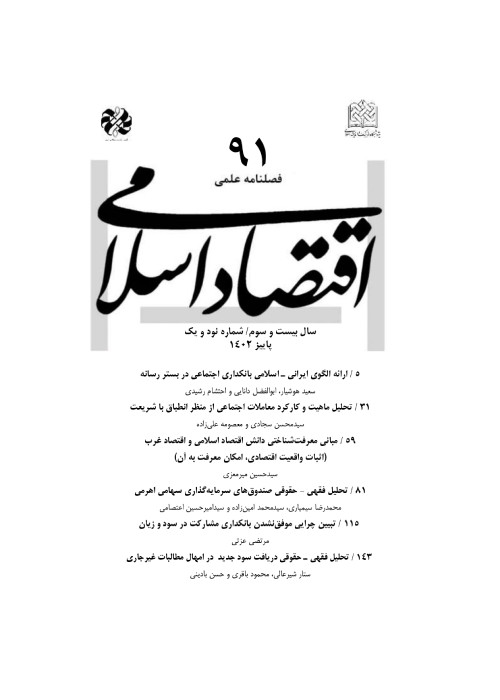فهرست مطالب

فصلنامه اقتصاد اسلامی
پیاپی 44 (زمستان 1390)
- 204 صفحه، بهای روی جلد: 40,000ريال
- تاریخ انتشار: 1390/11/25
- تعداد عناوین: 8
-
-
سازوکارهای اعمال قرارداد در اقتصاد اسلامی / تحلیل تطبیی هزینه های اعمال قرارداد در اقتصاد صدر اسلامصفحه 31
-
تحلیل و رتبه بندی ریسک های عملیاتی در بانکداری اسلامی / مطالعه موردی: بانکداری بدون ربا در ایرانصفحه 157
-
صفحه 187
-
Page 5The broad range of the meanings of justice and its increasing implementation indifferent fields such as social sciences and economics necessitates a coherent andreasonable explanation of the concept and content of social justice as the first brickof social justice geometry. This paper with the explanation of the concept, nature,classifications and important theories of social justice, seeks to show that the“putting the thing at its place” definition of social justice does not have sufficientsupport in literature, religious texts and scientific terms. The paper shows that thelexical meaning of justice is equality and its colloquial meaning in general justice isequality and correspondence of idea, practice, relation and states of self with rightthat is so called “observance of right”. In social justice, observing right necessitatesequality of all in implementation of law (without discrimination) and equality ofright giving with the degree of merit (without defect and supernumerary). In socialjustice, as the incomplete right giving is the violation of justice, going behind meritis also perfidy if it is treasury and is beneficence if it is personal property that bothof them are counted contrary to justice and such a meaning is more compatible with“giving every rightful his/her right” definition of justice. In the subsequent, thepaper analyses the meanings and practices of “right” and its meaning in socialjustice and shows that right considered in definition of social justice is a kind ofdominance and privilege for the rightful and is inseparable from creating obligationfor the rightful.Keywords: Social justice, Right, Sentence, Obligation, Wisdom, Rationality, Efficiency
-
Page 31“The present paper seeks to answer this question that “what are contract enforcement mechanisms in the Islamic economics and how these mechanisms affect the enforcement costs?”. Because the judgment on enforcement costs depends highly on the context of time and place, our study is devoted to the early Islamic time in the Arabian Peninsula. Therefore, after dividing enforcement mechanisms into private and public, we will show that North Arabian Peninsula in that time had no government and so no official Judiciary system as the most important public enforcement mechanism. So the Arab had no choice except referring to the private enforcement mechanisms that were so expensive and inefficient. However some contracts were enforced by the means of self-enforcement mechanisms because of continuity and repeatedness. After the dawn of Islam, the judiciary system and Hisbah mechanism was instituted and so the public enforcement became possible in the Arabian Peninsula. Along with the public mechanisms, Islam encouraged Muslim society to use private enforcement methods. In addition, the Islamic moral teachings were the most important means of self- enforcement. This paper concludes that the Islamic enforcement mechanisms were efficient in regard to minimizing transaction costs. So the “Cost Efficiency Principle” may be seen as an Islamic jurisprudential fundamental. This rule has priority until it is not contrasted with the basic Islamic rules such as judicial justice, not referring to tyrant (Taghut) and justice.Keywords: Law, Economics, contract enforcement mechanisms, transaction costs, Islamic economics of early Islamic time
-
Page 57This paper with descriptive-analytical method and methodology studies of sciences has explained the characteristics of interdisciplinary studies and has studied the necessities of Islamic economics as an interdisciplinary study. The results of this research show that disregarding scientific characteristics has led to different mixings in Islamic economics literature that we in this paper have indicated the improper understanding of concepts such as complete competition and monopoly, growth and development, scarcity, accumulation, rationality, speculation among Muslim economists and have explained the causes of such mixings. We have also indicated the mistakes in understanding some economic theories without regarding theoretical fundamentals among Muslim economists.Keywords: Interdisciplinary Sciences, Islamic Economics, Theoretical Pattern, Methodology
-
Page 77Economic crises of the capitalistic economics are one of the current phenomenon in which huge economic costs has been imposed on countries. The solutions provided within the capitalist system to prevent repeated economic crises and volatilities in financial markets, usually are temporary and could not solve the problem completely. This paper using an Islamic approach and a theoretical analysis has studied the role of monetary interest rate in formation economic crises within capitalist economics. The results indicate that monetary interest rate has a crucial role in limiting employment and production levels and causes inflation and uncertainty in economy. It also prevents the optimum resource allocation and sustainable equilibrium. So, the Islamic banking based, on real contracts of economy can eliminate the restrictions mentioned and induce the establishment of financial discipline. Therefore, from this aspect, The Islamic paradigm is more efficient than capitalist system.Keywords: Economic Crises, Capitalist system, Islamic System, Monetary Interest Rate, Riba
-
Page 105Swap contracts as derivative instruments have a great significance and are used widely in financial markets that commodity swap is one of them. Since Iran’s financial market is broadening, according to the regulations of Iran’s capital market, all of the instruments should be accepted by sharia’ rules. This paper using descriptive-analytical methodology in addition to recognition of the subject and the necessity of using commodity swap in Iran’s financial market, studies this contract from the fiqh-law viewpoint. On this base, after comparing swap and sale contracts, the nature of swap that is the nearer contract to commodity swap is studied in fiqh and law and is proven that swap is an independent contract from sale contract and is in accordance with fiqh rules, but the thing that is exchanged should be personal or a general thing on due. This paper recognizes the thing exchanged in commodity swap is out of the rules of swap and sale contract. It is also noted that the commodity swap cannot be corrected through obligation versus obligation, since It suffers from riba.Keywords: Price risk management, Commodity swap contract, Sale contract, Swap, Obligation versus obligation
-
Page 129Insurance industry faced a kind of doubt and damage in the start of 90th decade through middle of it after series of catastrophic events that resulted in lack of the world’s reinsurance capacity and the increase of reinsurance contracts’ prices in the world. On the other hand, increased value of insured assets in accident-prone areas resulted in disability of reinsurance corporations in hedging all of the risk. From then the thought of using capital market’s capacity and transformation of some share of insurance risks to this market was proposed. One of efficient and effective instruments for relating insurance industry and capital market – so called “securitization”- was presented and financial insurance instrument was introduced. These securities are based on bonds and therefore cannot be used in Iran. This paper tries to explain a model for issuance of these securities under the sharia’ rules and Iran’s laws. Therefore, according to the researches and interviews, the structure of financial wikala sukuk is suggested for implementation of catastrophic events securities.Keywords: Insurance securities, Securitization of insurance risk, Catastrophic events, Sukuk, Transformation of risk
-
Page 157Banks as the most important institutions of money market and the biggest intermediary in economy gets the deposits of deposit holders and gives loans to fund demanders. In Islamic economics, this role is on banks with regarding fundamentals and rules of shariah. Mobilization and allocation of resources by bank exposures the bank with some risks. Therefore, banks should identify, classify and rank these risks in order to manage them. Among different non-financial risks, operational risk has a great importance because of asset based activities of Islamic banking. Operational risks in Islamic economics include operational risks common between Islamic banking and conventional banking and operational risks specific to Islamic banking. This paper using descriptive methodology and AHP method aims to respond to these questions that: regarding mobilization and allocation of resources in usury-free banking, what are the most important operational risks of these banks? How these risks are classified regarding their nature? And finally, How these risks are ranked using AHP? The results show that first, generally operational risks in Islamic economics are classified into two general categories: operational risks common between Islamic banks and conventional banks and operational risks specific to Islamic banks. Second, in ranking these risks based on event possibility, in common risks class, IT and fraud risks and in specific risks class, transparency and discretionary payment risks have the most importance.Keywords: Islamic Banking, Risk, Operational risk, IT risk, Fraud risk, Proper services risk, Shariah risk, Fiduciary risk


